人教版(2019)选择性必修第一册Unit 2 Looking into the Future Video Time课件(21张PPT,内镶嵌视频)
文档属性
| 名称 | 人教版(2019)选择性必修第一册Unit 2 Looking into the Future Video Time课件(21张PPT,内镶嵌视频) |  | |
| 格式 | pptx | ||
| 文件大小 | 82.5MB | ||
| 资源类型 | 教案 | ||
| 版本资源 | 人教版(2019) | ||
| 科目 | 英语 | ||
| 更新时间 | 2023-09-05 17:53:25 | ||
图片预览

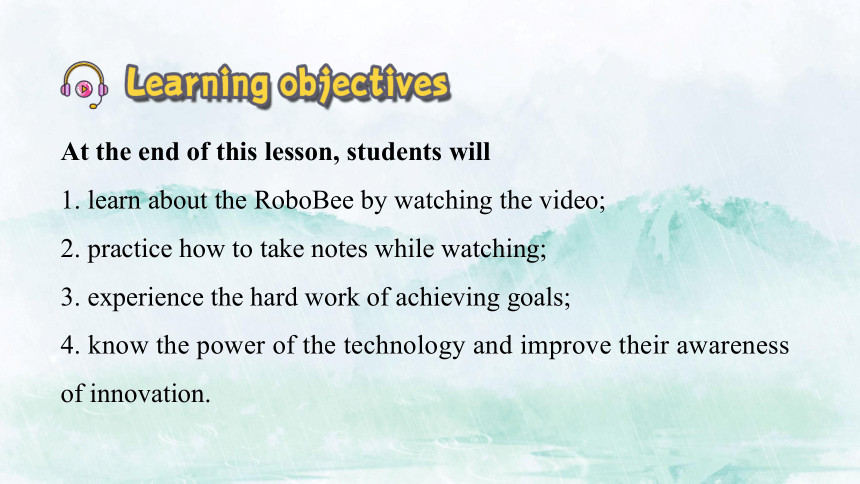
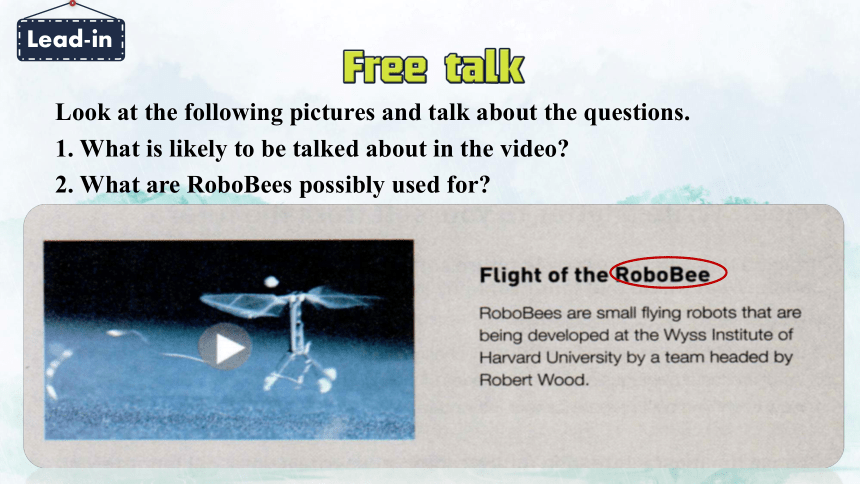
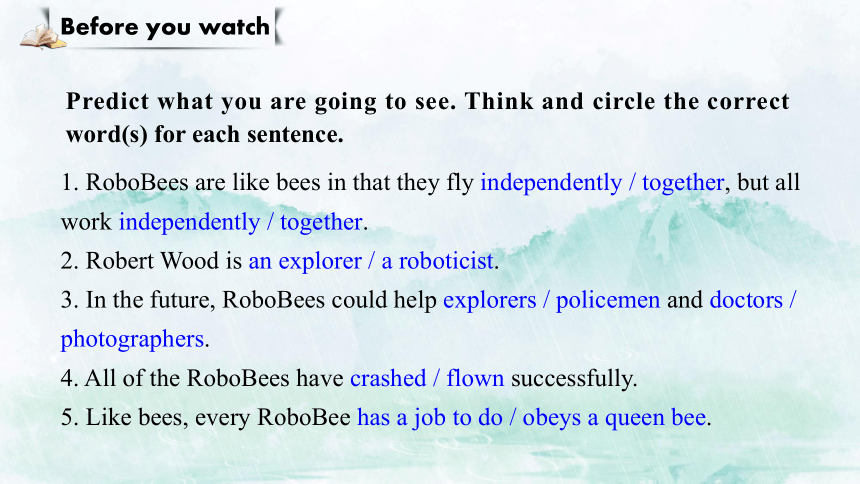
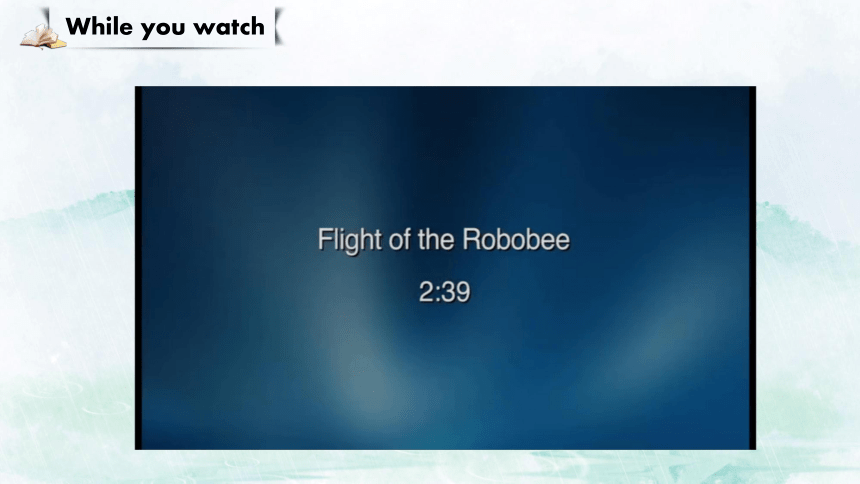


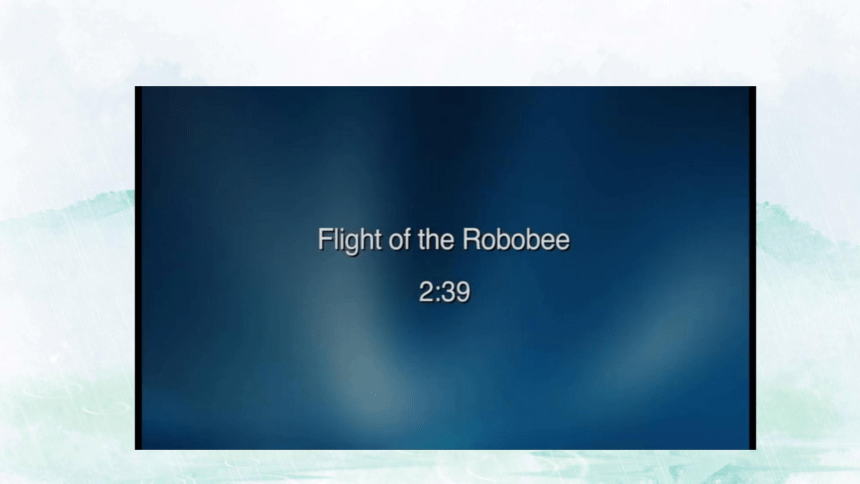
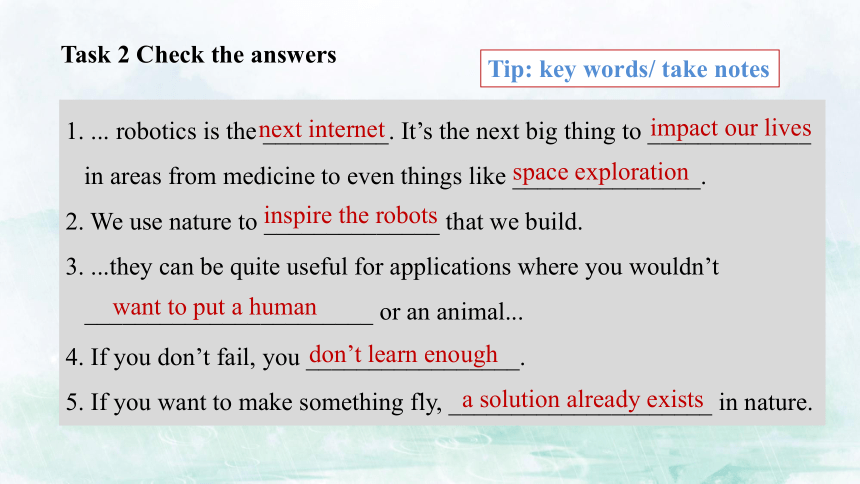
文档简介
Video Time
Unit 2
Looking into the future
At the end of this lesson, students will
1. learn about the RoboBee by watching the video;
2. practice how to take notes while watching;
3. experience the hard work of achieving goals;
4. know the power of the technology and improve their awareness of innovation.
Lead-in
Look at the following pictures and talk about the questions.
1. What is likely to be talked about in the video?
2. What are RoboBees possibly used for?
Predict what you are going to see. Think and circle the correct word(s) for each sentence.
1. RoboBees are like bees in that they fly independently / together, but all work independently / together.
2. Robert Wood is an explorer / a roboticist.
3. In the future, RoboBees could help explorers / policemen and doctors / photographers.
4. All of the RoboBees have crashed / flown successfully.
5. Like bees, every RoboBee has a job to do / obeys a queen bee.
Before you watch
While you watch
1. RoboBees are like bees in that they fly independently / together, but all work independently / together.
2. Robert Wood is an explorer / a roboticist.
3. In the future, RoboBees could help explorers / policemen and doctors / photographers.
4. All of the RoboBees have crashed / flown successfully.
5. Like bees, every RoboBee has a job to do / obeys a queen bee.
Task 1 Check your answers in Before You Watch.
Task 2 Complete the quotes by Robert Wood with words you hear
in the video.
1. ... robotics is the __________. It’s the next big thing to _____________ in areas from medicine to even things like _______________.
2. We use nature to ______________ that we build.
3. ...they can be quite useful for applications where you wouldn’t _______ or an animal...
4. If you don’t fail, you _________________.
5. If you want to make something fly, _____________________ in nature.
Task 2 Check the answers
1. ... robotics is the __________. It’s the next big thing to _____________ in areas from medicine to even things like _______________.
2. We use nature to ______________ that we build.
3. ...they can be quite useful for applications where you wouldn’t _______________________ or an animal...
4. If you don’t fail, you _________________.
5. If you want to make something fly, _____________________ in nature.
next internet
impact our lives
space exploration
inspire the robots
want to put a human
don’t learn enough
a solution already exists
Tip: key words/ take notes
What message do all these sentences intend to convey?
Robotics is very important and useful.
It is very creative.
Human beings are full of wisdom.
Failure is the mother of success.
It is not easy to achieve your dream, which needs many efforts.
Only through hard work and persistence can we reach our goals.
Thinking
After you watch
1. Specially, how might RoboBees be used in a future application?
2. What other kinds of robots can be created from nature (e.g. a robotic lion or snake)? How might these robots be used?
Task 3 Answer the questions.
1. Specially, how might RoboBees be used in a future application?
RoboBees
hazardous environment exploration
search and rescue
space exploration
assisted agriculture
E.g. If a building was blown down in a storm, they could fly into the wreckage and check for survivors.
1. Specially, how might RoboBees be used in a future application?
a robotic lion
a snake robot
2. What other kinds of robots can be created from nature (e.g. a robotic lion or snake)? How might these robots be used?
Other kinds of robots
butterfly
human beings
sea gull
dragonfly
dog
kangaroo
fish
……
2. What other kinds of robots can be created from nature (e.g. a robotic lion or snake)?
How might these robots be used?
Usages
01
02
03
04
05
entertainment
cooking
transportation
cleaning
exploration
E.g. A robotic spider could be useful as it could carry things across difficult uneven surface where wheeled vehicles can’t go.
This is Robert Wood. He loves robots. So I want to begin with a bold statement that robotics is the next internet. It’s the next big thing to impact our lives in areas from medicine to even things like space exploration. The more traditional view of robotics is big, rigid, very powerful, very dangerous...but in this case we’re making things smaller, perhaps faster, certainly cheaper than more traditional robotic systems. We are constructing robots the size of insects. We use nature to inspire the robots that we build. This is of a carpenter bee. And as an engineer, I can look at this and start to ask some really well-posed questions, you know like “how are the wings moving?” Our team is working on creating a colony of autonomous robotic bees.
Read together
[Text on screen]
RoboBees are autonomous. They can fly independently.
Robert Wood: We envision this, twenty or so years down the road, when these things actually exist, they can be quite useful for applications where you wouldn’t want to put a human or an animal—hazardous environment exploration, search and rescue, space exploration, assisted agriculture…
[Text on screen]
The tiny robots will help explorers, doctors, and even farmers.
Robert Wood: There’s all these really interesting open questions that must be solved if you’re gonna achieve this goal. We have to build everything from scratch. How many RoboBees have we crashed? Ah, all of them! We build, we test. We build, we test. If you don’t fail, you don’t learn enough. For everything that works, there’s tens or hundreds of things that don’t.
[Text on screen]
RoboBees work together like real bees.
Just like real bees, every RoboBee has a job to do.
Robert Wood: Now you have this concept where you have not just one all-capable robot, but you have a bunch of not very good robots. The idea is that the whole is greater than the sum of the parts.
[Text on screen]
If you want to make something fly, a solution already exists in nature.
—Rober Wood
Grasp the technology must grasp the education at the same time.
抓科技必须同时抓教育。
Summary
Suppose you are a roboticist and design a kind of robot. Write a passage to describe its appearance, function and features.
Homework
Unit 2
Looking into the future
At the end of this lesson, students will
1. learn about the RoboBee by watching the video;
2. practice how to take notes while watching;
3. experience the hard work of achieving goals;
4. know the power of the technology and improve their awareness of innovation.
Lead-in
Look at the following pictures and talk about the questions.
1. What is likely to be talked about in the video?
2. What are RoboBees possibly used for?
Predict what you are going to see. Think and circle the correct word(s) for each sentence.
1. RoboBees are like bees in that they fly independently / together, but all work independently / together.
2. Robert Wood is an explorer / a roboticist.
3. In the future, RoboBees could help explorers / policemen and doctors / photographers.
4. All of the RoboBees have crashed / flown successfully.
5. Like bees, every RoboBee has a job to do / obeys a queen bee.
Before you watch
While you watch
1. RoboBees are like bees in that they fly independently / together, but all work independently / together.
2. Robert Wood is an explorer / a roboticist.
3. In the future, RoboBees could help explorers / policemen and doctors / photographers.
4. All of the RoboBees have crashed / flown successfully.
5. Like bees, every RoboBee has a job to do / obeys a queen bee.
Task 1 Check your answers in Before You Watch.
Task 2 Complete the quotes by Robert Wood with words you hear
in the video.
1. ... robotics is the __________. It’s the next big thing to _____________ in areas from medicine to even things like _______________.
2. We use nature to ______________ that we build.
3. ...they can be quite useful for applications where you wouldn’t _______ or an animal...
4. If you don’t fail, you _________________.
5. If you want to make something fly, _____________________ in nature.
Task 2 Check the answers
1. ... robotics is the __________. It’s the next big thing to _____________ in areas from medicine to even things like _______________.
2. We use nature to ______________ that we build.
3. ...they can be quite useful for applications where you wouldn’t _______________________ or an animal...
4. If you don’t fail, you _________________.
5. If you want to make something fly, _____________________ in nature.
next internet
impact our lives
space exploration
inspire the robots
want to put a human
don’t learn enough
a solution already exists
Tip: key words/ take notes
What message do all these sentences intend to convey?
Robotics is very important and useful.
It is very creative.
Human beings are full of wisdom.
Failure is the mother of success.
It is not easy to achieve your dream, which needs many efforts.
Only through hard work and persistence can we reach our goals.
Thinking
After you watch
1. Specially, how might RoboBees be used in a future application?
2. What other kinds of robots can be created from nature (e.g. a robotic lion or snake)? How might these robots be used?
Task 3 Answer the questions.
1. Specially, how might RoboBees be used in a future application?
RoboBees
hazardous environment exploration
search and rescue
space exploration
assisted agriculture
E.g. If a building was blown down in a storm, they could fly into the wreckage and check for survivors.
1. Specially, how might RoboBees be used in a future application?
a robotic lion
a snake robot
2. What other kinds of robots can be created from nature (e.g. a robotic lion or snake)? How might these robots be used?
Other kinds of robots
butterfly
human beings
sea gull
dragonfly
dog
kangaroo
fish
……
2. What other kinds of robots can be created from nature (e.g. a robotic lion or snake)?
How might these robots be used?
Usages
01
02
03
04
05
entertainment
cooking
transportation
cleaning
exploration
E.g. A robotic spider could be useful as it could carry things across difficult uneven surface where wheeled vehicles can’t go.
This is Robert Wood. He loves robots. So I want to begin with a bold statement that robotics is the next internet. It’s the next big thing to impact our lives in areas from medicine to even things like space exploration. The more traditional view of robotics is big, rigid, very powerful, very dangerous...but in this case we’re making things smaller, perhaps faster, certainly cheaper than more traditional robotic systems. We are constructing robots the size of insects. We use nature to inspire the robots that we build. This is of a carpenter bee. And as an engineer, I can look at this and start to ask some really well-posed questions, you know like “how are the wings moving?” Our team is working on creating a colony of autonomous robotic bees.
Read together
[Text on screen]
RoboBees are autonomous. They can fly independently.
Robert Wood: We envision this, twenty or so years down the road, when these things actually exist, they can be quite useful for applications where you wouldn’t want to put a human or an animal—hazardous environment exploration, search and rescue, space exploration, assisted agriculture…
[Text on screen]
The tiny robots will help explorers, doctors, and even farmers.
Robert Wood: There’s all these really interesting open questions that must be solved if you’re gonna achieve this goal. We have to build everything from scratch. How many RoboBees have we crashed? Ah, all of them! We build, we test. We build, we test. If you don’t fail, you don’t learn enough. For everything that works, there’s tens or hundreds of things that don’t.
[Text on screen]
RoboBees work together like real bees.
Just like real bees, every RoboBee has a job to do.
Robert Wood: Now you have this concept where you have not just one all-capable robot, but you have a bunch of not very good robots. The idea is that the whole is greater than the sum of the parts.
[Text on screen]
If you want to make something fly, a solution already exists in nature.
—Rober Wood
Grasp the technology must grasp the education at the same time.
抓科技必须同时抓教育。
Summary
Suppose you are a roboticist and design a kind of robot. Write a passage to describe its appearance, function and features.
Homework
